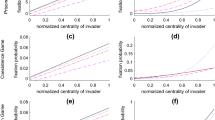Abstract
The agent-based multileader model of the stock price dynamics on the directed evolving complex network is studied by direct simulation. The resulting stationary regime follows from the balance of extremal dynamics, adaptivity of the strategic variables, and reconnection rules. For given parametric combination, the network displays small-world phenomenon with high clustering coefficients and power-law node degree distribution. The fitness exploration by the mechanism of repeated random walk is used to violate dominance of centralized leadership. The simulation suggests that ultra slow dynamics of fitness implies explanation of the long-time volatility of the log-price returns.
Similar content being viewed by others
References
R. Cont and J. P. Bouchaud, Macroecon. Dynam. 4, 170 (2000); D. Chowdhury and D. Stauffer, European Phys. J. B 8, 477 (1999); L. R. da Silva and D. Stauffer, Physica A 294, 235 (2001).
A. Ponzi and Y. Aizawa, Physica A 287, 507 (2000); S. Bornholdt, Int. J. Mod. Phys. C 12, 667 (2001); T. Kaizoji, S. Bornholdt, and Y. Fujiwara, Physica A 316, 441 (2002).
T. Takaishi, Int. J. Mod. Phys. C 16, 1311 (2005).
D. Challet and M. Marsili, Phys. Rev. E 60, R6271 (1999).
A. Greco, L. Sorriso-Valvo, and V. Carbone, physics/0601047 (2006).
A. Ilachinski and P. Halpern, Complex Syst. 1, 503 (1987).
G. Gigerenzer and R. Selten, Bounded Rationality (MIT, Cambridge, 2002).
H. Zhu, X. Wang, and J. Y. Zhu, Phys. Rev. E 68, 056121 (2003).
R. Albert and A.-L. Barabási, Rev. Mod. Phys. 74, 47 (2002).
D. Horváth, Z. Kuscsik, and M. Gmitra, Physica A 369, 780 (2006).
A. J. Bray and G. J. Rodgers, Phys. Rev. B 38, 11461 (1988); E. Almaas, R. V. Kulkarni, and D. Stroud, Phys. Rev. E 68, 056105 (2003).
P. Bak and K. Sneppen, Phys. Rev. Lett. 71, 4083 (1993).
R. N. Mantegna and E.H. Stanley, An Introduction to Econophysics: Correlations and Complexity in Finance (Cambridge Univ., Cambridge, 1999).
R. V. Solé and S. C. Manrubia, Phys. Rev. E 54, R42–R45 (1996).
D. Sornette, Why Stock Markets Crash: Critical Events in Complex Financial Systems (Princeton Univ., 2003); cond-mat/0301543.
S. N. Dorogovtsev and J. F. F. Mendez, cond-mat/0404593.
H. Ebel, J. Davidsen, and S. Bornholdt, Complexity 8, 24 (2003).
F. Lillo, S. Mike, and J. D. Farmer, Phys. Rev. E 7106(6 pt 2), 287 (2005).
Author information
Authors and Affiliations
Additional information
The text was submitted by the authors in English.
Rights and permissions
About this article
Cite this article
Horváth, D., Kuscsik, Z. The emergence of network communities by the action of coevolving market agents. Phys. Part. Nuclei Lett. 5, 211–214 (2008). https://doi.org/10.1134/S1547477108030151
Published:
Issue Date:
DOI: https://doi.org/10.1134/S1547477108030151




